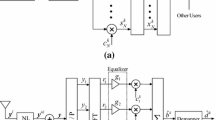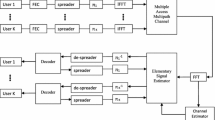Abstract
Radial basis function neural network is recognized as being the most useful type of neural network for a nonlinear equalizer in the CO-OFDM system. In the history of nonlinear equalizers, the focus has always been on mitigation of nonlinearity. Despite this interest, no one to the best of our knowledge has studied ultra-long-haul transmission length. Previous work has been limited to normal transmission length, i.e., up to 1400 km. In ultra-long-haul optical fiber communication systems, the optical signal becomes very much complex at longer distance, i.e., around over 8000 km. It has not yet been established whether radial basis function neural network can do the same improvement in performance at ultra-long-haul transmission length. A basic issue of a customary radial basis function neural system is its low performance at such a long distance. This paper presents a new approach to compensating nonlinearities in ultra-long-haul optical fiber communication CO-OFDM systems. In this new approach, a radial basis function with nonlinear equalizer (first hidden layer with automatically adjusted structure, i.e., number of neuron nodes in the hidden layer and the different parameters of the structure through learning, and second hidden layer with fixed structure) based on two hidden layers has been recommended. The aim of this study is to examine the performance of a self-organizing radial basis function neural network-based nonlinear equalizer (SORBFNN-NLE) for the mitigation of nonlinearities in ultra-long-haul CO-OFDM systems. Better performance of the SORBFNN is attributed due to self-organizing structure and training of network. From this study, it has been observed that the proposed SORBFNN-NLE performs well regarding Q-factor and OSNR at an ultra-long distance.









Similar content being viewed by others
References
Shieh, W., Bao, H., Tang, Y.: Coherent optical OFDM: theory and design. Opt. Express 16(2), 842–859 (2008)
van Nee, R.: OFDM codes for peak-to-average power reduction and error correction. In: Proceedings of IEEE Global Telecommunication Conference, pp. 740–744 (1996)
Savazzi, P., Favalli, L., Costamagna, E., Mecocci, A.: A suboptimal approach to channel equalization based on the nearest neighbor rule. IEEE J. Sel. Areas Commun. 16(9), 1640–1648 (1998)
Charalabopoulos, G., Stavroulakis, P., Aghvami, A.H.: A frequency domain neural network equalizer for OFDM. In: Proceedings of IEEE Global Telecommunications Conference, vol. 2, pp. 571–575 (2003)
Jarajreh, M.A., Giacoumidis, E., Aldaya, I., Le, S.T., Tsokanos, A., Ghassemlooy, Z., v, N.J.: artificial neural network nonlinear equalizer for coherent optical OFDM. IEEE Photonics Technol. Lett. 27(4), 387–390 (2015)
Kaur, G., Kaur, G.: Application of Functional Link Artificial Neural Network for Mitigating Nonlinear Effects in Coherent Optical OFDM. Springer, Optical and Quantum Electronics (2017)
Gan, Q., Subramanian, R., Sundararajan, N., Saratchandran, P.: Design for centers of RBF neural networks for fast time-varying channel equalization. Electron. Lett. 32(25), 2333–2334 (1996)
Ahmad, S.T., Kumar, K.P.: Radial basis function neural network nonlinear equalizer for 16-QAM coherent optical OFDM. IEEE Photonics Technol. Lett. 28(22), 2507–2510 (2016)
Han, H., Chen, Q., Qiao, J.: Research on an online self-organizing radial basis function neural network. Neural Comput. Appl. 19, 667–676 (2010). https://doi.org/10.1007/s00521-009-0323-6
Nam, M.D., Thanh, T.C.: Approximation of function and its derivatives using radial basis function networks. Appl. Math. Model. 27(3), 197–220 (2003)
Singh, J.K., Basu, D.K., Nasipuri, M., Kundu, M.: Face recognition using point symmetry distance-based RBF network. Appl. Soft Comput. 7(1), 58–70 (2007)
Zhao, T.: RBFN-based decentralized adaptive control of a class of large-scale non-affine nonlinear systems. Neural Comput. Appl. 1(4), 357–364 (2008)
Ram, D., Srivastava, L., Pandit, M., Sharma, J.: Corrective action planning using RBF neural network. Appl. Soft Comput. 7(3), 1055–1063 (2007)
Ibnkahla, M.: Applications of neural networks to digital communications—a survey. Sig. Process. 80(7), 1185–1215 (2000)
Author information
Authors and Affiliations
Corresponding author
Rights and permissions
About this article
Cite this article
Kaur, G., Kaur, G. Nonlinearities compensator based on SORBFNN in ultra-long-haul high-capacity CO-OFDM systems. Photon Netw Commun 36, 316–325 (2018). https://doi.org/10.1007/s11107-018-0782-8
Received:
Accepted:
Published:
Issue Date:
DOI: https://doi.org/10.1007/s11107-018-0782-8




